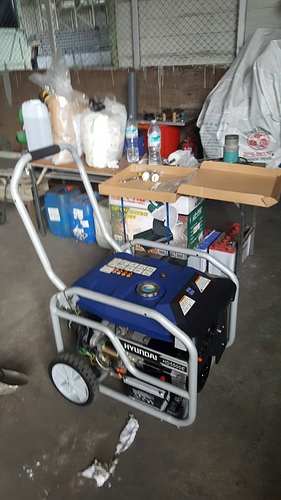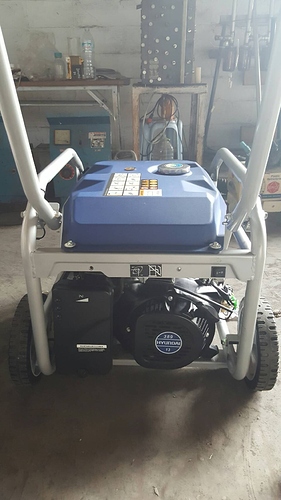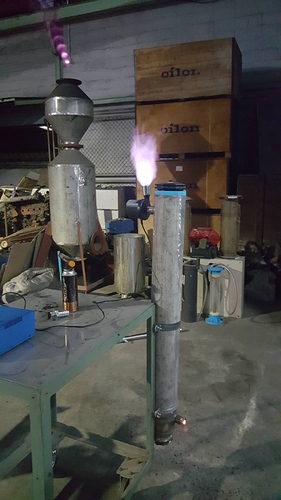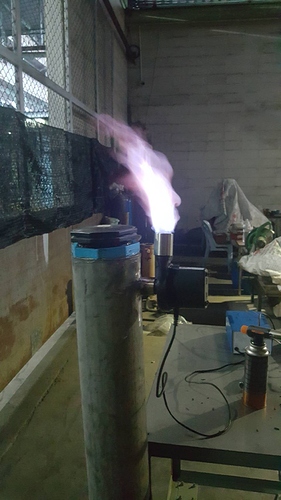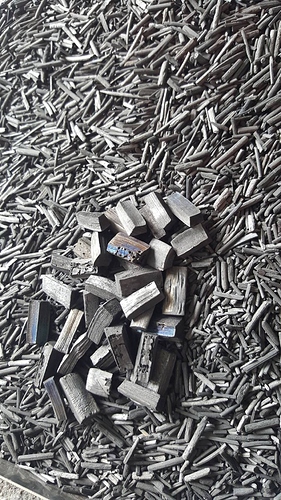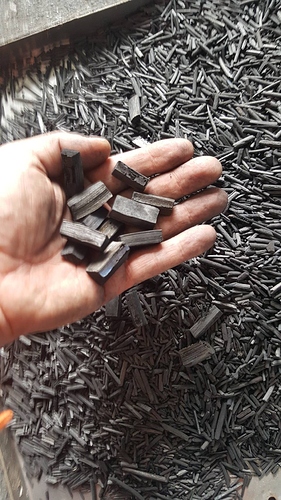Another tool / find on my scrapyard…
To be used for making gasifier fuel…
up sizing the holes from 1/2" to 1,1/2" should do some good…
Is that coconut log wedged with a coconut? 
Good work!
when felling a tree, escape at an angle close to 45 degrees. Trees like to toss stuff straight back toward your loved ones! For every action there is an opposite reaction. Nice work.
Damn, just arrived… too late , i have to catch a plane to Argos…
This beauty will have to wait for its own charcoal gas…
Replacement for the last Hyunday, just a tad bigger, 5 Kwh, 13 Hp
Hi Koen,
just found time to watch your videos. Funny to hear you speak German on the first one 
Wish you a good trip to Argos, the generator can wait until you are back 
Koen I am sure your already aware of this but be nervous about those corporate vouchers. They have a tendency to want to lock up technology with patterns so no one can use it.
If you can get funding and not give away the hard work you have done great but question everything when it comes to big companies.
been doing some test with the new toys around…
Been calculating… this gasifier does not cost more then about 100$…
enjoy the IR pictures
15 08-18
What is the height of the unit, diameter of tube, what is the nozzle construction, and what sort of blower? Looks like an air mattress blower?
What length of run time?
How will you regulate gas flow?
I know you like to clean out units daily, how is cleanout achieved?
Looks like a beautiful running unit, and the IR info is interesting, especially the peak temperatures.
In the one sepia tone pic you can make out a beam emanating from the nozzle, looks intense. 
Is this the model being released for public use?
Congratulations.
Yes what Garry said. Thank you for the pictures and temperature color scale. Very interesting on how the temperature distributes around the nozzle area. This could definitely help in design work. Congratulations on these achievements.
Bob
Very nice job Köen, the infrared pictures are jewels. I downloaded a few. Nice job, as always.
Hi Garry,
The total length of the pipe is about 48 "
Diameter 5"
Top cover is 4" blue pvc glued into the pipe with silicone
Bottom cover is any available grey cast iron flange with threaded hole, minimum size 2,5", favorable 4", with the fitting plug.
The nozzle is: female nipple 1" diameter, length 40 mm, thru the wall of the pipe ( same goes for the gas outlet )
This is solid welded about 4" above the bottom of the pipe. Solid thick welding for the heat transfer from nozzle towards the wall outer side. ( the thicker weld the better )
Top cover is 4" male plug, HDPE plastic, fitting in the female blue pvc glued in the top end of the pipe.
Gas outlet female nipple is about 3" from top
Distance between gas outlet and nozzle is about 40"
Useable about 20" before refill depending your charcoal.
My charcoal gets about 0,25 kg per liter, 20" is about 1,6 kg charcoal, runtime full throttle waterpump would be around 1 hour in this setup. A same sized engine generator would run a bit longer, almost double the time… if not under full load.
Engine size between 5,5 and 7 HP, running at 3000 RPM for the generator and 3600 for the waterpump
Nozzle depicted is made on a lathe from solid stainless, opening 16 mm
The filter, this is new, is inside the top of the pipe. Building another set now, to keep that as the “permanent” solution for this simple design.
yes, the blower is a air matrass blower, using them for 5 years now… no issues unless operator errors
The model aimed for distribution would be with a gas tank welded between the top and 20" above the bottom.
The name would be “Erawan Smart Farmer Gasifier”
More coming up from the Erawan Smart Farmer series…
Thanks for your detailed description. I think that will inspire some people to experiment.
I agree about the propane tank reservoir, makes good sense, as what Jeff Davis has done. For a stationary application do you feel the char may bridge between the curved transition and the pipe? A funnel might help?
What are you planning for third world charcoal grinding and sizing?
Hi Garry,
The lowest level for the charcoal is the curved transition. Some vibration of a running engine is most helpfull in preventing bridgeforming or cavity burning.
I am now experimenting with fuel size, but for the small gasifiers anything between 3 and 12 mm works best, with a regular spread of size this is.
i tried these in a last test , but could not even get it flaring, the pieces are at the long size <1", but no fine materials to fill the gaps between.
The smaller the gasifier… the smaller the fuel i guess 
A nice “dense” charcoal bed works best…
I would just be guessing but I suspect the smaller the gasifer the more of the volume the gaps become both spreading out the heat but also allowing too much air into the combustion zone hence no flare. I was trying to determine if temperature alone would be a good indicator. I suspect too much air will make the gasifer run too hot but i don’t know for sure.
Hi Dan,
Yes, to much air will run more combustion and not gasification… i am setting up my CO2 meter this week and repeat the test.
Maybe the smaller the fuel the smaller the reaction zone volume. Because smaller fuel has larger surface to volume ratio?
Rindert
Hi Koen
the nozzle is directed horizontally?
it is surprising that the wall of the pipe, which faces the nozzle, does not overheat! 
Thierry
Yup, you nailed it… 




